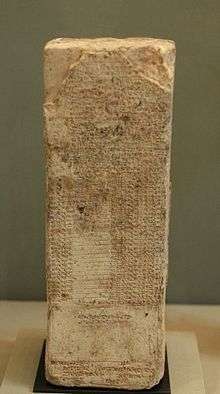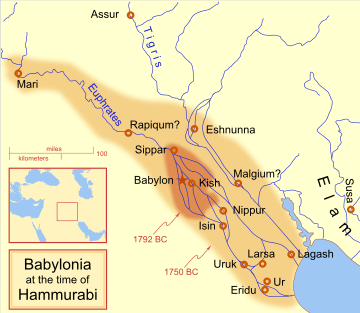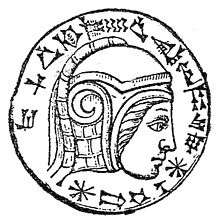List of kings of Babylon
The following is a list of the kings of Babylonia (ancient southern-central Iraq), compiled from the traditional Babylonian king lists and modern archaeological findings.
The Babylonian King List
The Babylonian King List is not merely a list of kings of Babylon, but is a very specific ancient list of supposed Babylonian kings recorded in several ancient locations, and related to its predecessor, the Sumerian King List. As in the latter, contemporaneous dynasties are misleadingly listed as successive without comment.
There are three versions, which are known as "King List A"[1] (containing all the kings from the First Dynasty of Babylon to the Neo-Assyrian king Kandalanu), "King List B"[2] (containing only the two first dynasties), and "King List C"[3] (containing the first seven kings of the Second Dynasty of Isin). A fourth version was written in Greek by Berossus. The "Babylonian King List of the Hellenistic Age" is a continuation that mentions all the Seleucid kings from Alexander the Great to Demetrius II Nicator.[4]
Middle Bronze Age
Early Amorite city-states
Kings of Larsa


| Ruler | Reigned | Comments |
|---|---|---|
| Naplanum | c. 1961–1940 BC | Contemporary of Ibbi-Suen of Ur III |
| Emisum | c. 1940–1912 BC | |
| Samium | c. 1912–1877 BC | |
| Zabaia | c. 1877–1868 BC | Son of Samium, First royal inscription |
| Gungunum | c. 1868–1841 BC | Gutian king who Gained independence from Lipit-Eshtar of Isin |
| Abisare | c. 1841–1830 BC | |
| Sumuel | c. 1830–1801 BC | |
| Nur-Adad | c. 1801–1785 BC | Contemporary of Sumu-la-El of Babylon |
| Sin-Iddinam | c. 1785–1778 BC | Son of Nur-Adad |
| Sin-Eribam | c. 1778–1776 BC | |
| Sin-Iqisham | c. 1776–1771 BC | Contemporary of Zambiya of Isin, Son of Sin-Eribam |
| Silli-Adad | c. 1771–1770 BC | |
| Warad-Sin | c. 1770–1758 BC | Possible co-regency with Kudur-Mabuk his father |
| Rim-Sin I | c. 1758–1699 BC | Contemporary of Irdanene of Uruk, Defeated by Hammurabi of Babylon, Brother of Warad-Sin |
| Hammurabi of Babylon | c. 1699–1686 BC | Official Babylonian rule, code of Hammurabi |
| Samsu-iluna of Babylon | c. 1686–1678 BC | Official Babylonian rule |
| Rim-Sin II | c. 1678–1674 BC | Killed in revolt against Babylon |
Babylonian Empire (Middle Bronze Age)
First Dynasty of Babylon, (Amorite Dynasty)

| Ruler | Reigned | Comments |
|---|---|---|
| Sumu-abum or Su-abu | c. 1830–1817 BC | Amorite chieftain, founder of independent Babylonian State, Contemporary of Erishum I of Assyria |
| Sumu-la-El | c. 1817–1781 BC | Contemporary of Ikunum of Assyria |
| Sabium or Sabum | c. 1781–1767 BC | Son of Sumu-la-El |
| Apil-Sin | c. 1767–1749 BC | Son of Sabium |
| Sin-muballit | c. 1748–1729 BC | Son of Apil-Sin |
| Hammurabi | c. 1728–1686 BC | Founded Babylonian Empire. Contemporary of Zimri-Lim of Mari, Siwe-palar-huppak of Elam and Shamshi-Adad I of Assyria |
| Samsu-iluna | c. 1686–1648 BC | Son of Hammurabi |
| Abi-eshuh or Abieshu | c. 1648–1620 BC | Son of Samsu-iluna |
| Ammi-ditana | c. 1620–1583 BC | Son of Abi-eshuh |
| Ammi-saduqa or Ammisaduqa | c. 1582–1562 BC | Venus tablet of Ammisaduqa |
| Samsu-Ditana | c. 1562–1531 BC | Deposed by Hitite king Mursilis in the Sack of Babylon. Last Amorite ruler. |
Sealand Dynasty (Dynasty II of Babylon)
These rulers may not have ruled Babylonia itself for more than the briefest of periods, but rather the formerly Sumerian regions south of it. Nevertheless, it is often traditionally numbered the Second Dynasty of Babylon, and so is listed here.
| Ruler | Reigned | Comments |
|---|---|---|
| Ilum-ma-ili | fl. c. 1732 BC | Contemporary of Samsu-iluna and Abi-ešuh |
| Itti-ili-nibi | ||
| Damqi-ilishu | His city walls for Der demolished by Ammi-Ditana | |
| Ishkibal | ||
| Shushushi | ||
| Gulkishar | ||
| mDIŠ+U-EN | Contemporary of LIK.KUD-Šamaš (Assyria) | |
| Peshgaldaramesh | ||
| Ayadaragalama | May have ruled briefly over Babylon | |
| Akurduana | ||
| Melamkurkurra | ||
| Ea-gamil | fl. c. 1460 BC | Overthrown by Kassite Ulam Buriaš |
Early Kassite Monarchs
This dynasty also did not actually rule Babylon, but their numbering scheme was continued by later Kassite Kings of Babylon, and so they are listed here.
| Ruler | Reigned | Comments |
|---|---|---|
| Gandaš | fl. c. 1730 BC | |
| Agum I | Known as Maḫrû, "the first," or rabi, "the great." | |
| Kaštiliašu I | Son of Agum I *according to the Agum-Kakrime Inscription | |
| Abi-Rattaš | Son of Kaštiliašu I *; may occupy fifth place, then Ušši or Uššiašu may come here | |
| Kaštiliašu II | ||
| Ur-zigurumaš | Descendant of Abi-Rattaš *; alternative reading Tazzigurumaš | |
| Ḫurbazum | Tell Muḥammed level 3, alternatively Ḫarba-Šipak/Šihu | |
| Šipta’ulzi | Tell Muḥammed level 2, alternatively Tiptakzi |
Late Bronze Age
Kassite Dynasty (Third Dynasty of Babylon)


Iron Age
Dynasty IV of Babylon, from Isin
The name of the dynasty, BALA PA.ŠE, is a paronomasia on the term išinnu, “stalk,” written as PA.ŠE and is the only apparent reference to the actual city of Isin.[5] It is therefore also known as the Second Dynasty of Isin or Isin II.

| Ruler | Reigned | Comments |
|---|---|---|
| Marduk-kabit-ahheshu | c. 1155–1140 BC | Founded first native Mesopotamian Dynasty in Babylon |
| Itti-Marduk-balatu | c. 1140–1132 BC | |
| Ninurta-nadin-shumi | c. 1132–1126 BC | |
| Nabu-kudurri-usur (Nebuchadnezzar I) | c. 1126–1103 BC | Contemporary and rival of Ashur-resh-ishi I of Assyria |
| Enlil-nadin-apli | c. 1103–1100 BC | Fought with Tiglath-Pileser I of Assyria |
| Marduk-nadin-ahhe | c. 1100–1082 BC | Fought with Tiglath-Pileser I of Assyria |
| Marduk-shapik-zeri | c. 1082–1069 BC | Entente cordial with Aššur-bêl-kala of Assyria |
| Adad-apla-iddina | c. 1069–1046 BC | Married daughter to Aššur-bêl-kala of Assyria |
| Marduk-ahhe-eriba | c. 1046 BC | |
| Marduk-zer-X | c. 1046–1033 BC | |
| Nabu-shum-libur | c. 1033–1025 BC | Dynasty ends with incursions of the Arameans |
Dynasty V of Babylon
Known as the 2nd Sealand Dynasty, the evidence that this was a Kassite Dynasty is rather tenuous.[6]
| Ruler | Reigned | Comments |
|---|---|---|
| Simbar-shipak | c. 1025–1008 BC | Deposed native dynasty, assassinated by his successor |
| Ea-mukin-zeri | c. 1008 BC | Usurper |
| Kashshu-nadin-ahi | c. 1008–1004 BC | Distressed times and famine |
Dynasty VI of Babylon
Known as the Bīt-Bazi Dynasty after the region from where this minor Kassite clan drew its ancestry.[7]
| Ruler | Reigned | Comments |
|---|---|---|
| Eulmash-shakin-shumi | c. 1004 – 987 BC | Founded Bīt-Bazi dynasty |
| Ninurta-kudurri-usur I | c. 987 – 985 BC | |
| Shirikti-shuqamuna | c. 985 BC |
Dynasty VII of Babylon
This was an Elamite Dynasty.
| Ruler | Reigned | Comments |
|---|---|---|
| Mar-biti-apla-usur | c. 985 – 979 BC | Elamite king who deposed the Arameans |
Dynasty VIII of Babylon
| Ruler | Reigned | Comments |
|---|---|---|
| Nabu-mukin-apli | c. 979 – 943 BC | Native Babylonian dynasty |
Dynasty IX of Babylon (Dynasty of E)

| Ruler | Reigned | Comments |
|---|---|---|
| Ninurta-kudurri-usur II | c. 943 BC | Succeeded his father Nabu-mukin-apli |
| Mar-biti-ahhe-iddina | c. 943 – 920 BC | Contemporary of Ashur-Dan II of Assyria |
| Shamash-mudammiq | c. 920 – 900 BC | Lost territory to Adad-nirari II of Assyria |
| Nabu-shuma-ukin I | c. 900 – 888 BC | Gained territory from Adad-nirari II of Assyria |
| Nabu-apla-iddina | c. 888 – 855 BC | |
| Marduk-zakir-shumi I | c. 855 – 819 BC | Subjugated by Shalmaneser III of Assyria |
| Marduk-balassu-iqbi | c. 819 – 813 BC | Subjugated by Shalmaneser III of Assyria |
| Baba-aha-iddina | c. 813 – 811 BC | Subjugated by Adad-nirari III of Assyria |
| 5 kings | c. 811 – 800 BC | Subjugated by Adad-nirari III of Assyria |
| Ninurta-apla-X | c. 800 – 790 BC | Briefly Freed Babylonia from Assyrian influence |
| Marduk-bel-zeri | c. 790 – 780 BC | |
| Marduk-apla-usur | c. 780 – 769 BC | Chaldean usurper, subjected by Assyria |
| Eriba-Marduk | c. 769 – 761 BC | Chaldean usurper, subjected by Assyria |
| Nabu-shuma-ishkun | c. 761 – 748 BC | Chaldean usurper, subjected by Assyria |
|
From this point on, the Babylonian chronology is securely known via Ptolemy's Canon of Kings and other sources. | ||
| Nabu-nasir (Nabonassar) | 748 – 734 BC | Overthrew Chaldeans, restored native Babylonian rule,Subjugated by Tiglath-Pileser III of Assyria |
| Nabu-nadin-zeri | 734 – 732 BC | |
| Nabu-suma-ukin II | 732 BC | King of Babylon for one month and two days. |
| Nabu-mukin-zeri | 732 – 729 BC | |
Dynasty X of Babylon (Assyrian)

| Ruler | Reigned | Comments |
|---|---|---|
| Tiglath-Pileser III | 729 – 727 BC | Assyrian king |
| Shalmaneser V | 727 – 722 BC | Assyrian king |
| Marduk-apla-iddina II | 722 – 710 BC | A Chaldean king, (the Biblical Merodach-Baladan) |
| Sharrukin II (Sargon II) | 710 – 705 BC | Assyrian king |
| Sin-ahhe-eriba (Sennacherib) | 705 – 703 BC | Assyrian king |
| Marduk-zakir-shumi II | 703 BC | Assyrian vassal |
| Marduk-apla-iddina II | 703 BC | Chaldean ruler retook Babylon from Assyria during uprising |
| Bel-ibni | 703 – 700 BC | Assyrian vassal |
| Ashur-nadin-shumi | 700 – 694 BC | Assyrian king, son of Sennacherib |
| Nergal-ushezib | 694 – 693 BC | Chaldean ruler, murdered Ashur-nadin-shumi |
| Mushezib-Marduk | 693 – 689 BC | Chaldean ruler |
|
Assyrian Sack of Babylon by Sennacherib , 689 BC; Babylon is rebuilt by Esarhaddon of Assyria in the 670s BC | ||
| Sin-ahhe-eriba (Sennacherib) | 689 – 681 BC | Assyrian king, destroyed Babylon |
| Ashur-ahha-iddina (Esarhaddon) | 681 – 669 BC | Assyrian king, rebuilt Babylon |
| Shamash-shum-ukin | 668 – 648 BC | Assyrian king, son of Esarhaddon, rebelled against his brother, Ashurbanipal and was killed. |
| Kandalanu | 648 – 627 BC | Assyrian governor under Ashurbanipal, rumoured to have been Ashurbanipal himself, also governor under Ashur-etil-ilani of Assyria between 631 BC and 627 BC |
| Sin-shumu-lishir | 626 BC | Assyrian king, Ruled Babylon, but lost control over regions in Babylonia. |
| Sinsharishkun | c. 626 – 620 BC | Assyrian king. Lost control over Babylonia in 620 BC. |
Dynasty XI of Babylon (Neo-Babylonian or Chaldean Dynasty)

| Ruler | Reigned | Comments |
|---|---|---|
| Nabu-apla-usur (Nabopolassar) | 626 – 605 BC | Chaldean king. Took control of Babylonia from Sinsharishkun of Assyria, ejected Assyrian armies from Babylonia in 616 BC. Entered into alliance with Cyaxares and destroyed Assyrian empire. |
| Nabu-kudurri-usur (Nebuchadnezzar II) | 605 – 562 BC | Chaldean king. Defeated the Egyptians and Assyrians at Carchemish. Is associated with Daniel in the Bible. |
| Amel-Marduk (Evil-Merodach) | 562 – 560 BC | Released Jeconiah after 37 years in captivity. |
| Nergal-shar-usur (Nergal-sharezer/Neriglissar) | 560 – 556 BC | Son-in-law of Nebuchadnezzar II. Murdered Amel-Marduk. |
| Labashi-Marduk | 556 BC | Son of Neriglissar. Murdered after being deemed unfit to rule. |
| Nabu-na'id (Nabonidus) | 556 – 539 BC | Last Mesopotamian king of Babylon, originated in Harran in Assyria. Was not a Chaldean, often left rule to his son Belshazzar. |
Achaemenid Babylonia
In 539 BC, Babylon was captured by Cyrus the Great. His son was later crowned formally as King of Babylonia. This list uses the Greek names of the Achaemenid Persian kings.
| Ruler | Reigned | Comments |
|---|---|---|
| Cyrus the Great | 539-530 BC | Conquered Babylon into the Persian Empire. |
| Cambyses II | 530 – 522 BC | Son of Cyrus the Great. |
| Bardiya | 522 BC | Son of Cyrus the Great (possible an usurper named Gaumata) Reigned only for seven months. |
| Darius I the Great | 521 – 486 BC | Son-in-law of Cyrus the Great and son of Hystaspes. |
| Xerxes I the Great | 485 – 465 BC | Son of Darius the Great and grandson of Cyrus the Great. Maybe the Ahasuerus mentioned in the Book of Esther. |
| Artaxerxes I Longimanus | 465 – 424 BC | Son of Xerxes the Great. Mentioned in the book of Ezra and the book of Nehemiah. |
| Xerxes II | 424 BC | Son of Artaxerxes Longimanus, reigned only for forty-five days. |
| Sogdianus | 424 – 423 BC | Illegitimate half-brother and rival of Xerxes II. |
| Darius II Nothus | 423 – 405 BC | Illegitimate half-brother and rival of Xerxes II. |
| Artaxerxes II Mnemon | 404 – 359 BC | Son of Darius Nothus, mentioned by Xenophon. |
| Artaxerxes III Ochus | 358 – 338 BC | Son of Artaxerxes Mnenon. |
| Artaxerxes IV Arses | 338 – 336 BC | Son of Artaxerxes Ochus. |
| Darius III Codomannus | 336 – 330 BC | Great-Grandson of Darius Nothus. |
Seleucid Babylonia
Babylon was captured by Alexander the Great in 330 BC. It was captured by the Parthians in 141 BC.
| Ruler | Reigned | Comments |
|---|---|---|
| Alexander III the Great | 330 – 323 BC | |
| Alexander IV | 323 – 309 BC | |
| Seleucus I Nicator | Satrap 311 – 305 BC, King 305 – 281 BC | |
| Antiochus I Soter | co-ruler from 291, ruled 281 – 261 BC | |
| Antiochus II Theos | 261 – 246 BC | |
| Seleucus II Callinicus | 246 – 225 BC | |
| Seleucus III Ceraunus (or Soter) | 225 – 223 BC | |
| Antiochus III the Great | 223 – 187 BC | |
| Seleucus IV Philopator | 187 – 175 BC | |
| Antiochus IV Epiphanes | 175 – 164 BC | |
| Antiochus V Eupator | 164 – 162 BC | |
| Demetrius I Soter | 161 – 150 BC | |
| Alexander III Balas | 150 – 145 BC | |
| Demetrius II Nicator | first reign, 145 – 141 BC | |
| Antiochus VI Dionysus | jointly with Demetrius II, 145 – 142 BC | |
See also
References
- ↑ BM 33332.
- ↑ BM 38122.
- ↑ The text is in a private collection and was published in: Arno Poebel (1955). "Second Dynasty of Isin According to a New King-List Tablet". Assyriological Studies. University of Chicago Press (15).
- ↑ Meissner, Bruno (1990). Reallexikon der Assyriologie. 6. Berlin: Walter de Gruyter. p. 90. ISBN 3-11-010051-7.
- ↑ J. A. Brinkman (1999). Dietz Otto Edzard, ed. Reallexikon Der Assyriologie Und Vorderasiatischen Archäologie: Ia – Kizzuwatna. 5. Walter De Gruyter. pp. 183–184.
- ↑ Bruno Meissner (1999). Dietz Otto Edzard, ed. Reallexikon Der Assyriologie Und Vorderasiatischen Archäologie: Meek - Mythologie. Walter De Gruyter. p. 8. “The Kassite name of Simbar-Šipak, the Kassite derived theothoric element (dKaššû = “the Kassite (god)”) in the name of the third king, and the tribal affiliation of the second monarch could suggest that this dynasty represented a revival of Kassite power following the native Babylonian rulers of the Second Dynasty of Isin; but the evidence at present must be regarded as tenuous.”
- ↑ J. A. Brinkman (1982). "Babylonia, c. 1000 – 748 B.C.". In John Boardman; I. E. S. Edwards; N. G. L. Hammond; E. Sollberger. The Cambridge Ancient History (Volume 3, Part 1). Cambridge University Press. pp. 296–297.